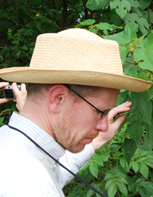Richard Telford’s Blog
 @richardjtelford
@richardjtelford
Recent Comments
-
Recent Posts
- Resampling Assemblage Counts
- A demo targets plan for reproducible pipelines for Neotoma data
- Reproducibility of high resolution reconstruction – one year on
- Simplistic and Dangerous Models
- COVID-19, climate and the plague of preprints
- Erroneous information … was given
- Making a pollen diagram from Neotoma
Archives
Categories
Tags
- analogue quality
- autocorrelation
- Baffin Island
- Barycentre
- Benthic foraminifera
- Bob Irvine
- Bulafu et al (2013)
- calibration-in-time
- China
- chironomids
- chrysophytes
- climate models
- critical transition
- data archiving
- diatoms
- Dietl (2016)
- dinocysts
- Doug Keenan
- EDA
- graphics
- Guiot and de Vernal (2011)
- h-block cross-validation
- Heartland
- impact
- INTIMATE training school
- Kelsey et al 2015
- Klein et al (2013)
- Klemm et al 2013
- lake level
- Lake Silvaplana
- Larocque-Tobler et al (2010)
- Larocque-Tobler et al (2011)
- Larocque-Tobler et al (2012)
- Larocque-Tobler et al (2015)
- LGM
- Liu et al 2014
- Lyons et al 2016
- maps
- Marcott et al 2013
- Mauri et al (2015)
- Miller et al 2013
- moss
- Murry Salby
- neotoma
- NIPCC
- Norway
- ocean acidification
- ordination
- palaeoSig
- Peer review
- Planktonic foraminifera
- Poland
- pollen
- R
- radiocarbon calibration
- radiocarbon dating
- Reconstruction diagnostics
- reconstructions
- REDFIT
- Schulz & Mudelsee (2002)
- Sea ice
- sea ice reconstruction
- Skjærvø et al (2015)
- spatial autocorrelation
- Spectral analysis
- Tatra Mountains
- Telford (2006)
- Telford and Birks (2011)
- Testate amoeba
- Transfer function diagnostics
- Uganda
- uneven sampling
- Willie Soon
- Younger Dryas
- Zhang et al 2017
Blogroll
Follow me on Twitter
My TweetsMeta
- Follow Musings on Quantitative Palaeoecology on WordPress.com
Category Archives: Palaeohydrology
Autocorrelation in the testate amoeba calibration set
Amesbury et al examine the autocorrelation in their huge calibration set. I thought I would do the same, increasing the resolution of the analysis to get a better handle on what is going on. This is an RNE plot. It … Continue reading
Testing testate amoeba: some comments on Amesbury et al (2018)
Today, I have been reading and thinking about a new paper presenting a huge testate-amoeba calibration set for reconstructing water table depth in bogs (Amesbury et al 2018). This calibration set, with almost 2000 samples, is the synthesis of many … Continue reading
Posted in Palaeohydrology, Peer reviewed literature, transfer function
Tagged Amesbury et al (2018), Testate amoeba
1 Comment
The elevation of Lake Tilo
For my PhD, I studied the palaeolimnology of two lakes in the Ethiopian rift valley, using diatoms to reconstruct changes in the water chemistry of Lake Awassa, an oligosaline caldera lake which retains its low salinity despite having no effluent … Continue reading
Posted in Data manipulation, Palaeohydrology, R, Uncategorized
Tagged lake level, Lake Tilo, Telford and Lamb (1999)
Leave a comment
Significance testing testate amoeba water table reconstructions
Testate amoeba live in bogs, their shell or test is preserved in the peat after death. Some species seem to prefer drier conditions, others prefer wetter conditions. And thus we have the prerequisites for constructing a transfer function to reconstruct … Continue reading
Posted in Palaeohydrology, transfer function
Tagged Payne et al 2016, Testate amoeba
Leave a comment
You don’t have to explain everything
So many papers present interesting palaeo-data and then add a badly done analysis that attempts to prove that the palaeo-data correlate (if you squint hard enough) with the Carriaco Basin record, NGRIP or the solar insolation reconstruction. This is not … Continue reading
On the niche of Thalassiosira faurii, perils in palaeoecology
Palaeoenvironmental conditions can be reconstructed from microfossils preserved in sediments using the relationship between species and the environment. Usually the species’ relationships with the environment — their niches — are insufficiently constrained by experimental data, so we are forced to rely upon observations of … Continue reading
Mayfly mandibles: as seen in the IPCC report
I have been reading through the palaeoclimate chapter in the new IPCC report, in part so I can write a post on transfer functions in the report for Victor Venema’s climate scientists’ reviews. This post is not that review, instead I want … Continue reading
Posted in climate, Novel proxies, Palaeohydrology, Peer reviewed literature
Tagged caddisfly, IPCC AR5, Luoto et al (2013), mayfly
Leave a comment
Hydrological modelling of a small lake – implications for palaeohydrology
Palaeohydrological studies on closed-lakes (lakes without an outflowing river) make a lot of sense. I did my PhD on this type of system in Ethiopia. When the precipitation/evaporation ratio is high, lake level is high and salinity is low, and … Continue reading
Posted in climate, Palaeohydrology, Peer reviewed literature, transfer function
Tagged Harp Lake, lake level, palaeohydrology, Yao et al
Leave a comment
The Water Lilies – Setting Sun: Review of Stolze et al (2013)
This is part of my critical review of the palaeoenvironmental evidence for the influence of solar activity on climate. Stolze, S., Muscheler, R., Dörfler, W., Nelle, O. (2013) Solar influence on climate variability and human development during the Neolithic: evidence from a … Continue reading
